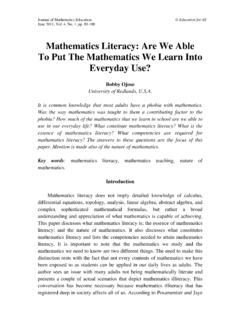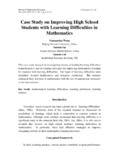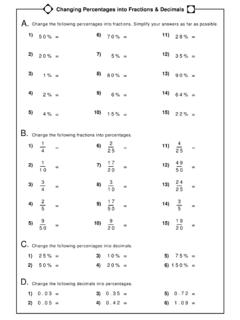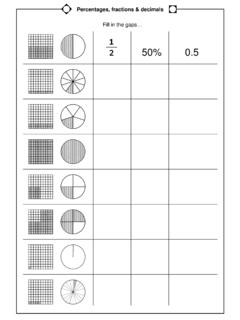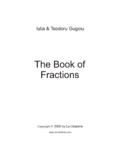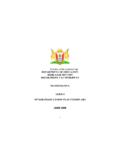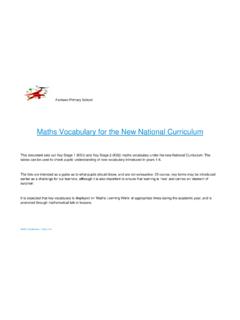Transcription of Error Patterns in Addition and Subtraction of …
1 Journal of Mathematics Education Education for All December 2011, Vol. 4, No. 2, pp. 35-54 Error Patterns in Addition and Subtraction of fractions among Form Two Students Noraini Idris Sultan Idris Education University, Tanjong Malim, Perak Latha Maheswari Narayanan University of Malaya This article discusses the types of errors and the pattern of systematic errors often made by students in the operation of Addition and Subtraction of fractions . The sample consisted of 80 Form Two students from a national secondary school in the Selangor state. The research instrument consists of a set of paper and pencil tests containing 40 items in Addition and 40 items in the Subtraction of fractional operations.
2 The findings indicate that errors in Addition operations are careless errors, negligence errors and systematic random errors. In systematic errors, of students have a problem converting to the lowest common denominator, encounter problems in the process of understanding, and have problems dealing with improper fractions . As for the Subtraction of fractions , there are systematic errors, careless errors, and random errors. In systematic errors, of students faced problems in the process of understanding. Background of Study Research on students ability to perform operations on fractions has shown disappointingly poor results. Researchers have consistently commented on the huge percentage of individuals lacking basic fraction skills.
3 In Malaysia too our children face difficulties with fractions both in primary and secondary school (Nur Fazilah, 2002; Valarmathy, 2004; Wan, 2002). An examination of fraction development in the mathematics text book recommended by the Ministry of Education Malaysia reveals that foundation work in fraction development begins early in the children s schooling, which is in Year Three. A recurring area of concern for classroom teachers is that students in the primary school face problems in fractions (Nur Fazilah, 2002; 36 Idris & Narayanan Valarmathy, 2004). Most alarmingly, although they have been exposed to the computing of fractions , students in secondary school still make significant errors in the Addition and Subtraction of fractions (Wan, 2002).
4 A survey done by Kim (2003) on topics that are difficult in school mathematics reveals that all the 329 schools in Penang have listed fractions as one of the most difficult topics at the primary and secondary level. The Malaysian Mathematics curriculum (MOE, 2002) currently is in alignment with the National Council of Teachers of Mathematics (NTCM, 2000) current standards where students in grade 6-8 continue to refine their understanding of arithmetic operations on fractions and develop algorithms for computing with fractions . A study by Yea-Ling (2005) revealed that fractions were more difficult than decimals or whole numbers for low ability students. Low ability students tended to use rule-based methods more often than high ability students.
5 Furthermore, low ability students relied on standard written algorithms more than reflecting on number-sense based methods. Different difficulties occur when students use fractions and when they use decimals. Students in the low ability group misunderstood the concept that multiplication does not always make the answer larger. Students errors are often systematic and rule-based rather than random (Yetkin, 2003). In Addition to student inventiveness, these errors may be caused by instruction that focuses on rote memorization. Students abstract or generalize procedures from following the steps in worked-out examples, but when their knowledge is rote or insufficient they might over generalize the rules and procedures.
6 For example, students having difficulty in adding fractions may extrapolate erroneous algorithms from instruction on the representation of fractions . Students who are often presented fractions using pie graphs perform 1/2+1/3=2/5 and justify the solution as adding one piece of a two piece pie and one piece of a three piece pie will result in two pieces out of five pieces altogether. Using appropriate representations will help students construct different characteristics of these concepts. In the past decades formal arithmetic with fractions in primary schools generally resulted in the great majority of students having to follow meaningless rules of calculation.
7 As a consequence Watanabe (2001) recommends shifting the subject of formal reasoning with fractions from primary to secondary education. The arguments were based on issues related to curriculum, development and instructional materials. On the contrary, Powel and Hunting (2003) feel that the fraction concepts are developmentally Error Patterns in Addition 37 appropriate for primary age children and should not be delayed until the intermediate grades, but rather nurtured and built upon throughout the students school careers. They emphasize that the mathematical power that these children will bring to higher education and discovery becomes more personal if the concept of fraction is taught earlier.
8 Afzal Ahmad et al. (2004) illustrated that one of the difficulties in learning fractions , decimals and percentages is that they have multiplicity of meanings. This means that any particular number, say 3/5 (or or 60%) can be interpreted concretely in many ways, all of which occur in many real-life applications. This is in contrast to whole numbers, which are used mainly either for counting discrete objects or counting repetitions of measuring units as in working out lengths, and so on. One of the most frustrating subjects for teachers as well as their students is the study of fraction and more particularly, operations with fractions . Year after year, the students seem to learn to add, subtract, multiply and divide with fractions but it quickly becomes apparent that they tend to forget it all.
9 An analysis of errors will pinpoint specific computational weaknesses in the Addition and Subtraction of fractions that are experienced by the majority of students. Research on analysis of computational errors indicates that recognizing the Error Patterns of a child is the first step towards remediation (Cox, 1975). Ashlock s (1998) study on Error Patterns in computation also supports this. Ashlock noted that teachers need to be more sensitive to what pupils do if they want their pupils to compute successfully. To be able to do this, a purposeful diagnostic test has to be constructed; the pupil s written responses have to be analyzed and individual interview need to be conducted very carefully.
10 As teachers identify and analyze pupils errors, the procedures they used in their computations and the causes of their errors, teachers will gain understanding of the errors made. This will be very useful in helping them to develop effective instructional strategies. The recent National Assessment of Educational Progress report shows that fractions are exceedingly difficult for children to master (NAEP, 2001, p. 5). Additionally, students are frequently unable to remember prior experiences with fractions from lower grade levels (Groff, 1996). The NCTM states that just as students are struggling with learning fractions , so too are teachers feeling frustrated as they seek ways of teaching fractions effectively.


